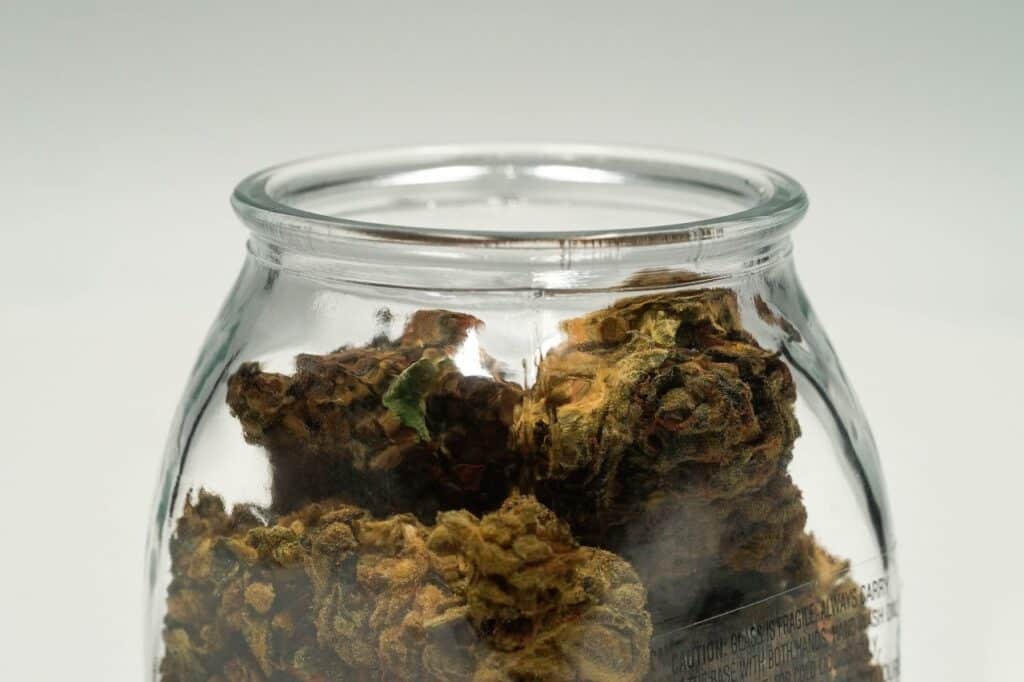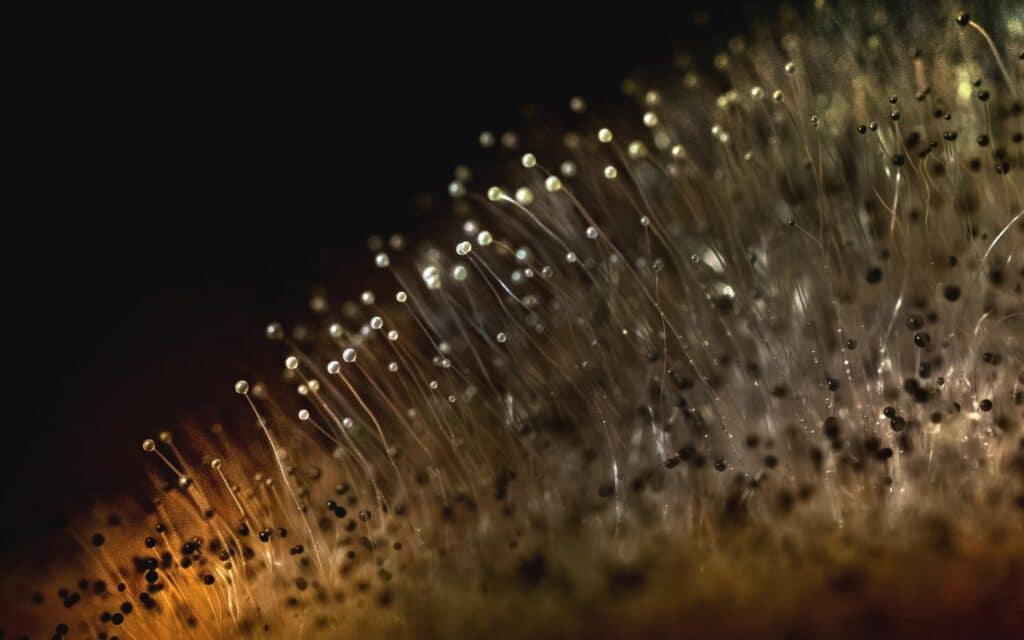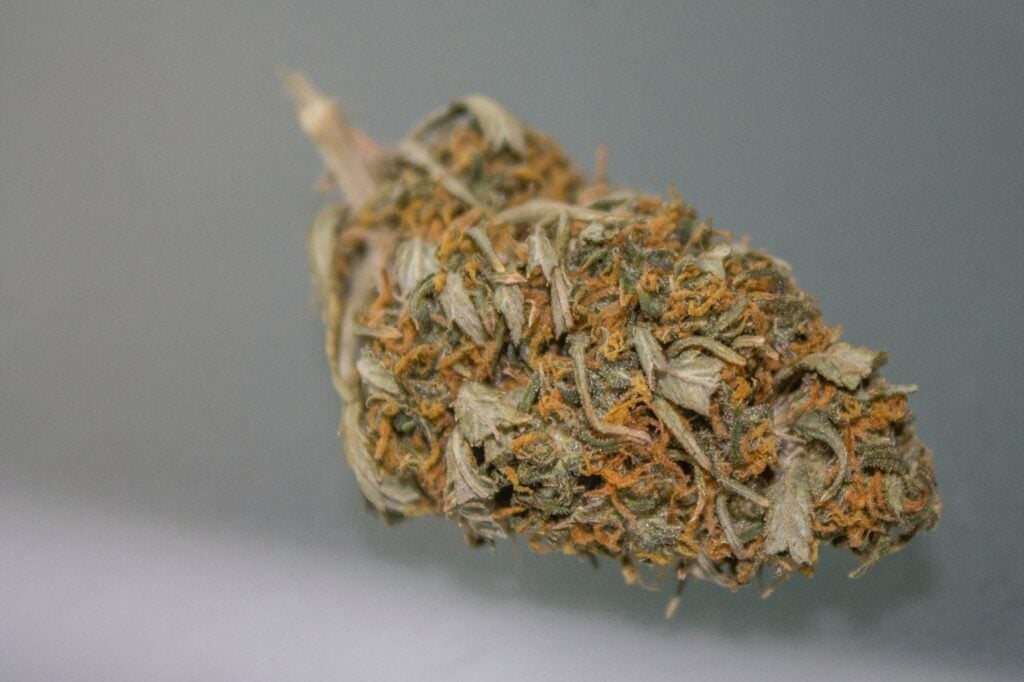Moldy Weed | Risks, Identification, and Smoking Safety

Mold on weed is a big bummer. Not only is it a safety risk but it’s also a financial loss. You pay good money for your cannabis and the idea of discarding it in the trash can is a major buzz kill. Can you smoke moldy weed?
While that’s usually a negative, the question of what happens when you get moldy weed is one that deserves further consideration. Which is exactly why we have gathered you all here today. In this article, we take an in-depth look at all the questions weighing on your mind. What does moldy weed look like? What happens if you smoke moldy weed? Read on to find out.
How Marijuana Gets Moldy
To understand how mold forms on weed it’s first important to understand how it forms in general. Mold spores hang in the air everywhere. Even inside your house, the right conditions can bring mold particles indoors.
So why isn’t everything covered in mold? The spores need a special set of circumstances to form. The surface that the mold spores land on needs to be moist, humid, and—depending on the mold—dark. Have you ever noticed moldy patches in your garden immediately after a summer rain? It’s because all of the right conditions for mold to grow have suddenly been met.
Cannabis, though dry, naturally contains a small degree of moisture. When mold particles come into contact with it they can begin to form. It doesn’t take much time either. From the moment a particle lands in a spot that meets the right criteria, microbial growth can begin to form in 24 hours.
So here’s a scenario. You have a nice jar of cannabis. You’re vaguely aware of how to store cannabis and have placed this bud in an airtight mason jar. There’s just one problem. You—in a moment of reduced mental faculties, perhaps—left the jar lid slightly unfastened. In your humid kitchen. Next to an open window.

To make matters worse, it’s a tightly packed jar, filled up the very top. In there, the mold spores have lots of room to fester. They start on the bottom of the jar where the majority of bud has accumulated, but by the time you catch the problem, it has proliferated through the jar.
So here’s another question—if it’s really that simple, why doesn’t cannabis get moldy all the time? Few and far between are the cannabis enthusiasts who have never forgotten to properly seal their bud, after all.
There are a few factors that work in your favor. For one thing, processed cannabis flower has been dried to the point that it is easily combustible. This creates an environment that isn’t necessarily naturally conducive to mold growth.
There’s also a question of quantity and storage duration. If you have a dime bag, there’s not that much room for moisture to hide and accumulate. What’s more, you probably won’t have it around long enough to give the microbial growth time to develop.
Identifying Moldy Weed

If you’re on the fence about whether or not your cannabis has mold on it, chances are that it probably does. Though the fuzzy trichomes on cannabis can somewhat resemble certain forms of microbial growth, the unique appearance and smell of a full-blown mold outbreak are usually unmistakable.
However, mold outbreaks can happen gradually, during which period it may be harder to discern the signs.
Signs of mold contamination on your dried cannabis can include but are not limited to:
Powdery appearance
The trichomes on the outside of your cannabis flower should have a hairy, almost glistening appearance. Mold spores can look hairy, but generally have a duller white/ grey appearance that will look muted relative to the natural glisten of a beautiful trichome.
Smell
We all know how a nice back of dank cannabis smells. It’s a powerful scent that can easily overwhelm adjacent smells. However, if you begin to notice a mildewy scent, that is a sure sign that some form of microbial growth has begun to develop on your bud. You may encounter a musty smell that is similar to aged bread.
Grainy, rough texture

Mold has a crumbly texture. Unfortunately, dry cannabis can as well, which can confuse the issue somewhat. Nevertheless, experienced cannabis users do know what their bud consistency should feel like. If the texture of your weed changes suddenly, it is either a sign that the bud has acquired microbial growth, or that it has aged out of freshness. Either way, it’s not a great situation.
Because mold can accumulate very quickly, it’s important to monitor the conditions of your cannabis every time before you smoke it. You don’t need to do a full eighteen-point inspection to keep yourself safe. Usually, you will be just fine giving the bud a once over.
Can You Smoke Moldy Weed? The Health Risks Involved
Obviously, it’s not good to ingest mold. You’re not really supposed to even be in the same room as mold spores, so the idea of deliberately burning it up and inhaling it into your lungs is not smart.
The adverse symptoms that can arise from smoking moldy weed usually pop up right away. They can include but are not limited to:
Coughing
Of course, smoking cannabis often involves a great deal of coughing. This sensation will probably feel a little different. Your lungs may begin to feel hot and scratchy, and the coughs may develop an out-of-control croupy quality that bears little in common with your average weed smoke cough.

Nausea
Nausea is another symptom that is sometimes associated with a “THC overdose” (more THC than your body can comfortably handle). If you routinely get nauseous smoking cannabis, you can most likely safely disregard this concern. However, nausea is a relatively rare cannabis side effect, so if you experience it randomly out of the blue, it may be a good idea to monitor yourself closely for other symptoms of mold ingestion.
Vomiting
Pretty straightforward. If you begin throwing up shortly after smoking cannabis it’s usually a sign that something isn’t right.
Inflammation
Mold on your cannabis can leave your lungs dangerously inflamed. This isn’t a very subtle feeling so you should be able to recognize it right away when you encounter it. Your lungs will feel scratchy and uncomfortable. The inflammation may also transfer to your sinuses, resulting in intense leakage.
People with pre-existing conditions—asthma, respiratory disease, etc.—are at a much greater risk of experiencing significant consequences. If you begin to experience side effects, consider seeking medical attention right away—particularly if you begin to struggle to breathe.
This probably goes without saying at this point, but if you notice cannabis on any of your buds, it is best to throw out the entire container. The risk of smoking corrupted cannabis far outweighs any perceived benefit.
Preventing Mold Growth on Marijuana
Proper storage is the best way to avoid microbial growth on your cannabis. Airtight containers can go a long way toward keeping your weed safe. As long as the container is sealed tightly enough to avoid letting air in, there should be no risk that mold spores will get in the first place.
For long-term storage, you should think about the location where you are keeping the cannabis. The best location for storing cannabis is:
Dry
Remember that humid conditions are naturally conducive to mold growth. Humidity is itself just moisture that hangs heavily in the air. If it manages to accumulate on your stored bud it will create ideal conditions for mold to grow and proliferate. There are numerous humidity control products on the market that will keep your stash in the optimal range for freshness and to reduce mold exposure. Look for products like the ones below that keep the humidity between 58%-62%.

Light
This is actually a bit of a toss-up. For one thing, experts typically recommend a dark, dry storage area because light can accelerate the staleness factor. If you have a large quantity of weed that you want to keep fresh for a long time you will usually be better off keeping it in a cabinet or something similarly dark and cool. However, it is important to keep in mind that most types of mold don’t tolerate light well. That’s one of the reasons it thrives in HVAC, in between walls, and at the base of leafy plants. You may decide that you do want to store your weed in a dark place. If you follow all of our other recommendations, that should be ok. Still, it’s good to understand what effect different variables will have on your cannabis plant.
Cool
The ideal temperature for mold growth is between 60-80 degrees. Admittedly, it can be hard to find a spot inside your house that is below 60 degrees, particularly in the warmer months. If you have a nice dry cellar that might do the trick—though you should monitor the humidity levels carefully. Regardless, it’s best to keep your cannabis in as cool an environment as possible. Aha! You think to yourself. I will store it in the refrigerator. No, don’t do that. While the refrigerator might be the only place in your home that can dependably maintain a sub-sixty-degree temperature the cons outweigh the pros. Regular temperature fluctuations that come from taking your cannabis in and out of the fridge can create excessive moisture accumulation, which will inevitably create greater mold growth potential.
Note that similar criteria can be applied to help you keep mold off a living cannabis plant. On that front, you will want to keep the plant well-trimmed. Cannabis leaves are a prime source of moisture and can retain water very well. When moisture accumulates on leaves, mold spores can grow for weeks on spots that are not immediately visible, before spreading to the rest of the plant.
There are fungicides available that will help you avoid spore growth. Proper plant spacing and regular monitoring can go a long way toward helping you avoid encountering issues with mold. There are anti-fungal/microbial spore sprays that can help with your problem.
It’s always easier to keep microbial growth off your plants indoors than out but no area is completely immune to the spread of mold spores. Keep in mind that much of mold prevention happens during the curing process. Weed that has been properly dried and cured has less internal moisture and is therefore more immune to the ravaging effects of spore growth.
If you are curing the cannabis yourself you can reduce your risks of microbial growth by following many of the same precautions that keep your cannabis safe during the dry storage phase. If you are buying cannabis from a grower you know, feel free to ask them about how they handle the curing process. They will usually be happy to tell you about their approach to the process, and may even be willing to provide you additional tips on how you can avoid microbial growth.
Be it bud or the plants themselves, vigilance and regular monitoring are the best ways to prevent yourself from encountering significant issues.
Conclusion
There’s never a good reason to smoke moldy cannabis. Best case scenario, you wind up feeling really bad. Worst case scenario, you wind up in the hospital. If you find mold on your cannabis, it’s always best to throw out the container and take better care of your bud the next time around.
Of course, it’s always best to take good preventative action. Store your cannabis in a cool, dry spot. Weigh the merits of using sunlight to your advantage, and make a habit of routinely inspecting your cannabis. And remember: airtight containers are your friend. Cannabis can’t become corrupted if the container is tight enough to prevent mold spores and moisture access.
While mold is pervasive and fast-growing, the steps required to keep it at bay are easy to follow. There is never a good reason to risk your health for a smoke.
- Psilocybin Mushrooms in Colorado | Is It Legal & Where You Can Get Some - April 20, 2024
- Weed Measurements Guide: Marijuana Quantities, Weights & Prices - July 1, 2023
- Moldy Weed | Risks, Identification, and Smoking Safety - June 24, 2023
